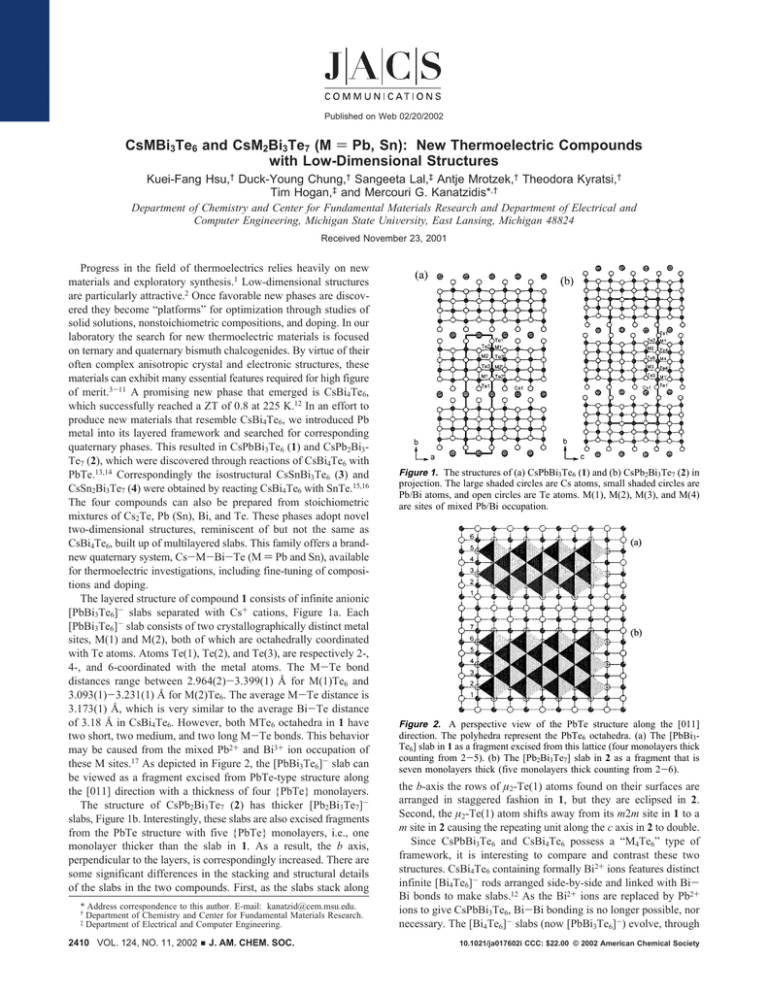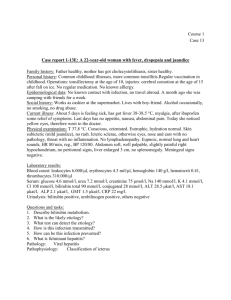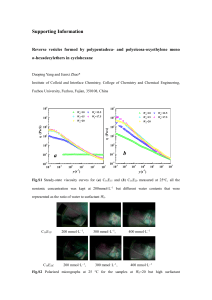CsMBi3Te6 and CsM2Bi3Te7 (M = Pb, Sn): New Thermoelectric
advertisement

Published on Web 02/20/2002
CsMBi3Te6 and CsM2Bi3Te7 (M ) Pb, Sn): New Thermoelectric Compounds
with Low-Dimensional Structures
Kuei-Fang Hsu,† Duck-Young Chung,† Sangeeta Lal,‡ Antje Mrotzek,† Theodora Kyratsi,†
Tim Hogan,‡ and Mercouri G. Kanatzidis*,†
Department of Chemistry and Center for Fundamental Materials Research and Department of Electrical and
Computer Engineering, Michigan State UniVersity, East Lansing, Michigan 48824
Received November 23, 2001
Progress in the field of thermoelectrics relies heavily on new
materials and exploratory synthesis.1 Low-dimensional structures
are particularly attractive.2 Once favorable new phases are discovered they become “platforms” for optimization through studies of
solid solutions, nonstoichiometric compositions, and doping. In our
laboratory the search for new thermoelectric materials is focused
on ternary and quaternary bismuth chalcogenides. By virtue of their
often complex anisotropic crystal and electronic structures, these
materials can exhibit many essential features required for high figure
of merit.3-11 A promising new phase that emerged is CsBi4Te6,
which successfully reached a ZT of 0.8 at 225 K.12 In an effort to
produce new materials that resemble CsBi4Te6, we introduced Pb
metal into its layered framework and searched for corresponding
quaternary phases. This resulted in CsPbBi3Te6 (1) and CsPb2Bi3Te7 (2), which were discovered through reactions of CsBi4Te6 with
PbTe.13,14 Correspondingly the isostructural CsSnBi3Te6 (3) and
CsSn2Bi3Te7 (4) were obtained by reacting CsBi4Te6 with SnTe.15,16
The four compounds can also be prepared from stoichiometric
mixtures of Cs2Te, Pb (Sn), Bi, and Te. These phases adopt novel
two-dimensional structures, reminiscent of but not the same as
CsBi4Te6, built up of multilayered slabs. This family offers a brandnew quaternary system, Cs-M-Bi-Te (M ) Pb and Sn), available
for thermoelectric investigations, including fine-tuning of compositions and doping.
The layered structure of compound 1 consists of infinite anionic
[PbBi3Te6]- slabs separated with Cs+ cations, Figure 1a. Each
[PbBi3Te6]- slab consists of two crystallographically distinct metal
sites, M(1) and M(2), both of which are octahedrally coordinated
with Te atoms. Atoms Te(1), Te(2), and Te(3), are respectively 2-,
4-, and 6-coordinated with the metal atoms. The M-Te bond
distances range between 2.964(2)-3.399(1) Å for M(1)Te6 and
3.093(1)-3.231(1) Å for M(2)Te6. The average M-Te distance is
3.173(1) Å, which is very similar to the average Bi-Te distance
of 3.18 Å in CsBi4Te6. However, both MTe6 octahedra in 1 have
two short, two medium, and two long M-Te bonds. This behavior
may be caused from the mixed Pb2+ and Bi3+ ion occupation of
these M sites.17 As depicted in Figure 2, the [PbBi3Te6]- slab can
be viewed as a fragment excised from PbTe-type structure along
the [011] direction with a thickness of four {PbTe} monolayers.
The structure of CsPb2Bi3Te7 (2) has thicker [Pb2Bi3Te7]slabs, Figure 1b. Interestingly, these slabs are also excised fragments
from the PbTe structure with five {PbTe} monolayers, i.e., one
monolayer thicker than the slab in 1. As a result, the b axis,
perpendicular to the layers, is correspondingly increased. There are
some significant differences in the stacking and structural details
of the slabs in the two compounds. First, as the slabs stack along
* Address correspondence to this author. E-mail: kanatzid@cem.msu.edu.
† Department of Chemistry and Center for Fundamental Materials Research.
‡ Department of Electrical and Computer Engineering.
2410 VOL. 124, NO. 11, 2002
9
J. AM. CHEM. SOC.
Figure 1. The structures of (a) CsPbBi3Te6 (1) and (b) CsPb2Bi3Te7 (2) in
projection. The large shaded circles are Cs atoms, small shaded circles are
Pb/Bi atoms, and open circles are Te atoms. M(1), M(2), M(3), and M(4)
are sites of mixed Pb/Bi occupation.
Figure 2. A perspective view of the PbTe structure along the [011]
direction. The polyhedra represent the PbTe6 octahedra. (a) The [PbBi3Te6] slab in 1 as a fragment excised from this lattice (four monolayers thick
counting from 2-5). (b) The [Pb2Bi3Te7] slab in 2 as a fragment that is
seven monolayers thick (five monolayers thick counting from 2-6).
the b-axis the rows of µ2-Te(1) atoms found on their surfaces are
arranged in staggered fashion in 1, but they are eclipsed in 2.
Second, the µ2-Te(1) atom shifts away from its m2m site in 1 to a
m site in 2 causing the repeating unit along the c axis in 2 to double.
Since CsPbBi3Te6 and CsBi4Te6 possess a “M4Te6” type of
framework, it is interesting to compare and contrast these two
structures. CsBi4Te6 containing formally Bi2+ ions features distinct
infinite [Bi4Te6]- rods arranged side-by-side and linked with BiBi bonds to make slabs.12 As the Bi2+ ions are replaced by Pb2+
ions to give CsPbBi3Te6, Bi-Bi bonding is no longer possible, nor
necessary. The [Bi4Te6]- slabs (now [PbBi3Te6]-) evolve, through
10.1021/ja017602i CCC: $22.00 © 2002 American Chemical Society
COMMUNICATIONS
Consequently, the novel two-dimensional structures in these systems
define two potentially promising adaptable platforms for thermoelectric investigations.
Acknowledgment. Financial support from ONR and DARPA
is gratefully acknowledged.
Supporting Information Available: Tables of crystallographic
details, atomic coordinates, bond lengths and angles, and anisotropic
thermal parameters for all compounds (CIF). This material is available
free of charge via the Internet at http://pubs.acs.org.
References
Figure 3. Variable-temperature electrical conductivity and thermopower
data for oriented polycrystalline ingot samples of (a) CsPbBi3Te6 (1) and
(b) CsPb2Bi3Te7 (2). The crosses are thermopower.
cleavage of Bi-Bi bonds and formation of new Bi(Pb)-Te bonds,
into the infinite slabs shown in Figure 1a.
In both structures, the Cs cations are surrounded by nine Te atoms
with Cs-Te distances between 3.433(3) and 4.243(6) Å. The
resulting tricapped trigonal prismatic environment is similar to that
found in CsBi4Te6. Occupancy refinement of the Cs(1) sites showed
85% for 1 and 91% for 2. Therefore, to maintain electroneutrality
the final formulas were adjusted to be Bi-rich compositions;
Cs1-xPb1-xBi3+xTe6 (x ) 0.15) of 1 and Cs1-xPb2-xBi3+xTe7 (x )
0.09) of 2. The isostructural Sn analogues gave similarly Csdeficient stoichiometries.15,16
Charge transport measurements on polycrystalline ingots of 1
and 2 show high electrical conductivity at room temperature, which
increases as the temperature drops.
The conductivities decrease from 1010 S/cm at 80 K to 800 S/cm
at 350 K for 1 and from 970 S/cm at 80 K to 570 S/cm at 350 K
for 2, Figure 3. The thermopower of 1 and 2 is -50 and -57 µV/K
at 350 K, respectively, rising to higher values with rising temperature. These conductivities are affected by the morphological defects
(crack, grain boundaries, etc) of the ingots used. The intrinsic
conductivities are probably much higher. The relatively low
thermopower and metallic-like temperature dependence of conductivity of 1 and 2 indicate that both materials are heavily doped and
are reminiscent of those of CsBi4Te6 before being optimized through
doping. The negative sign of thermopower indicates n-type charge
transport in these compounds. This is consistent with their Bi-rich
nonstoichiometric nature suggested by the elemental analysis and
crystallographic refinement. A Bi-rich/Pb-deficient stoichiometry
will result in electron carrier excess in these materials giving rise
to negative thermopower, as Bi possesses an extra electron
compared to Pb. Presumably, a Pb-rich/Bi-deficient stoichiometry
would lead to p-type behavior. The thermal conductivities at room
temperature are very low at 1.8 W/(m‚K) for 1 and 1.6 W/(m‚K)
for 2, comparable to those of Bi2Te3 and CsBi4Te6.12
The new structure types reported here are able to form a number
of other isostructural members (in addition to 3 and 4) such as
rubidium analogues and antimony CsPbSb3Te6 and CsPb2Sb3Te7.
(1) (a) Slack, G. A. New Materials and Performance Limits for Thermoelectric
Cooling. In CRC Handbook of Thermoelectrics; Rowe, D. M., Ed.; CRC
Press: Boca Raton, FL, 1995; p 407. (b) Kanatzidis, M. G. Semicond
Semimet 2000, 69, 51-100. (c) Mahan, G. D. Good thermoelectrics. In
Solid State Phys. 1998, 51, 81. (d) DiSalvo, F. J. Science 1999, 285, 703.
(2) Dresselhaus, M. S.; Dresselhaus, G.; Sun, X.; Zhang, Z.; Cronin, S. B.;
Koga, T.; Ying, J. Y.; Chen, G. The promise of low-dimensional
thermoelectric materials. In Microscale Thermophyl. Eng. 1999, 3, 89.
(3) Iordanidis, L.; Brazis, P. W.; Kyratsi, T.; Ireland, J.; Lane, M.; Kannewurf,
C. R.; Chen, W.; Dyck, J. S.; Uher, C.; Ghelani, N. A.; Hogan, T.;
Kanatzidis, M. G. Chem. Mater. 2001, 13, 622.
(4) Choi, K. S.; Chung, D. Y.; Mrotzek, A.; Brazis, P.; Kannewurf, C. R.;
Uher, C.; Chen, W.; Hogan, T.; Kanatzidis, M. G. Chem. Mater. 2001,
13, 756.
(5) Wang, Y. C.; DiSalvo, F. J. Chem. Mater. 2000, 12, 1011.
(6) Shelimova, L. E.; Karpinskii, O. G.; Zemskov, V. S.; Konstantinov, P. P.
Inorg. Mater. 2000, 36, 235.
(7) Chung, D. Y.; Lane, M. A.; Ireland, J. R.; Brazis, P. W.; Kannewurf, C.
R.; Kanatzidis, M. G. Mater. Res. Soc. Symp. 2000, 626, Z7.4.1.
(8) Mrotzek, A.; Chung, D. Y.; Hogan, T.; Kanatzidis, M. G. J. Mater. Chem.
2000, 10, 1667.
(9) Iordanidis, L.; Kanatzidis, M. G. Angew. Chem., Int. Ed. 2000, 39, 1927.
(10) Oosawa, Y.; Tateno, Y.; Mukaida, M.; Tsunoda, T.; Imai, Y.; Isoda, Y.;
Nishida, I. A. Proc. Inter. Conf. Thermoelect. 1999, 550.
(11) Chung, D. Y.; Jobic, S.; Hogan, T.; Kannewurf, C. R.; Brec, R.; Rouxel,
J.; Kanatzidis, M. G. J. Am. Chem. Soc. 1997, 119, 2505.
(12) Chung, D. Y.; Hogan, T.; Brazis, P.; Rocci-Lane, M.; Kannewurf, C. R.;
Bastea, M.; Uher C.; Kanatzidis M. G. Science 2000, 287, 1024.
(13) CsPbBi3Te6 (1) was obtained by reacting CsBi4Te6 (0.252 g, 0.145 mmol),
Pb (0.0301 g, 0.145 mmol), and Te (0.0186 g, 0.146 mmol) at 600 °C for
1 h and slow cooling to 50 °C. CsPb2Bi3Te7 (2) was obtained by reacting
CsBi4Te6 (0.203 g, 0.117 mmol), Pb (0.0728 g, 0.351 mmol), and Te
(0.0448 g, 0.351 mmol) at the same heating profile with 1. Both
compounds can be prepared by the stoichiometric reactions of Cs2Te, Pb,
Bi, and Te reagents. A quantitative microprobe analysis using energy
dispersive spectroscopy (EDS) on >10 crystals gave an average molar
ratio of Cs:[Pb(Bi)]:Te of 0.86:[4.10]:6.14 for 1 and 0.95:[4.97]:7.3 for
4. The microprobe analyses do indicate a Bi-rich composition.
(14) Crystal data: (1), Cs0.85Pb0.85Bi3.15Te6, orthorhombic, space group Cmcm,
black needlelike crystal, a ) 6.3322(6) Å, b ) 28.667(3) Å, c ) 4.3637(4) Å, T ) 273 K, V ) 792.1(2) Å3, Z ) 4, final refinement converged
to R1(F) ) 0.0391, wR2(F2) ) 0.1049. (2), Cs0.91Pb1.91Bi3.09Te7, orthorhombic, Cmcm, black needlelike crystal, a ) 4.3456(6) Å, b ) 32.476(5) Å, c ) 12.508(2) Å, T ) 273 K, V ) 1765.2(7) Å3, Z ) 8, final R1(F)
) 0.0410, wR2(F2) ) 0.1131, GOF ) 1.062. The metal sites in both
structures were refined as Bi atoms due to the nearly identical scattering
lengths of Pb and Bi.
(15) CsSnBi3Te6 (3) was obtained by reacting CsBi4Te6 (0.301 g, 0.173 mmol),
Sn (0.0206 g, 0.173 mmol), and Te (0.0221 g, 0.173 mmol) at 750 °C for
1 h and slow cooling to 50 °C. CsSn2Bi3Te7 (4) was obtained by reacting
CsBi4Te6 (0.302 g, 0.174 mmol), Sn (0.0620 g, 0.522 mmol), and Te
(0.0667 g, 0.523 mmol) at the same heating profile with 3. Both
compounds can be prepared by the stoichiometric reactions of Cs2Te, Sn,
Bi, and Te reagents. EDS analysis on several crystals gave an average
composition of Cs0.87Sn0.73Bi3.30Te6.25 for 3 and Cs0.93Sn1.82Bi3.25Te7.20 for
4.
(16) Crystal data: (3), Cs0.84Sn0.84Bi3.16Te6, Cmcm, black needlelike crystal, a
) 6.2613(7) Å, b ) 28.479(3) Å, c ) 4.3207(5) Å, T ) 273 K, V )
770.4(3) Å3, Z ) 4, final refinement converged to R1(F) ) 0.0467, wR2(F2) ) 0.1358, GOF ) 1.213. (4), Cs0.88Sn1.88Bi3.12Te7, Cmcm, a ) 4.3881(6) Å, b ) 33.139(4) Å, c ) 12.608(2) Å, T ) 273 K, V ) 1833.4(7) Å3,
Z ) 8, final R1(F) ) 0.0353, wR2(F2) ) 0.0872. The refinements of metal
sites in 3 showed 18.0(4)% Sn occupancy in the Bi(1) site and 24.0(4)%
in the Bi(2) site. The refinements of metal sites in 4 showed 23.4(2)% Sn
in the Bi(1) site, 50.8(4)% Sn in the Bi(2) site, 41.2(4)% Sn in the Bi(3)
site, and 49.6(4)% Sn in the Bi(4) site. The final formulas of 3 and 4
were adjusted to be Cs1-xSn1-xBi3+xTe6 (x ) 0.16) and Cs1-xSn2-xBi3+xTe7
(x ) 0.12), respectively.
(17) As suggested by valence bond sum calculations, both Pb2+ and Bi3+ ions
appear to occupy the two metal sites. Brown, I. D. J. Appl. Crystallogr.
1996, 29, 479.
JA017602I
J. AM. CHEM. SOC.
9
VOL. 124, NO. 11, 2002 2411




